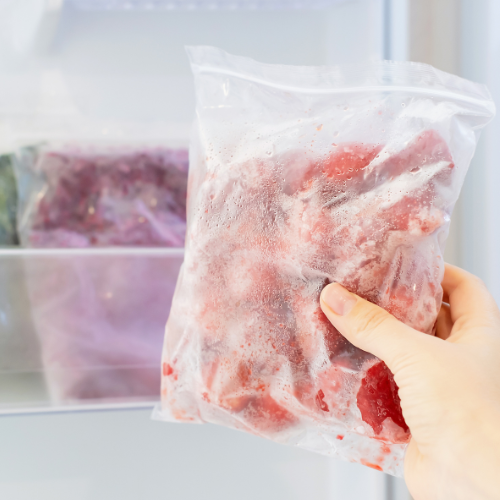Freezing food is a convenient way to reduce waste and save time. Many items — like soups, stews, and frozen fruits — handle the freezer beautifully, maintaining their texture and flavor when properly stored.
However, not all foods are freezer-friendly. Some lose their texture, separate, or become inedible after thawing, leaving you with disappointing results.
To help you avoid common mistakes, here are 15 foods you should never freeze.
Milk and Cream-Based Sauces
While freezing milk or cream might seem like a good way to extend their shelf life, these items tend to separate when thawed, creating a grainy, watery texture. The same goes for cream-based soups and sauces.
Leafy Greens for Fresh-Tasting Salads
Leafy greens like lettuce, spinach and kale don’t retain their original texture once frozen and defrosted due to their high water content. This means freezing lettuce and other leafy greens to be used later in fresh salads isn’t recommended.
However, it’s okay to freeze greens if you plan to use them for things like soups and smoothies. Just place them washed (and de-stemmed if kale) in a freezer bag and grab a handle when you need them to your morning smoothies, etc.
Cooked Pasta
Freezing cooked pasta often results in a gummy, mushy texture when reheated. If you’re preparing meals ahead of time, consider freezing the sauce separately and cooking fresh pasta when needed. If freezing is your only option, cook the pasta al dente and toss it with a little oil before storing.
Raw Potatoes
As with leafy greens, raw potatoes don’t handle freezing well due to their high water content, and they become mushy and grainy when defrosted. Keep raw potatoes in a cool, dry place away from direct sunlight for long-term storage.
Eggs in the Shell
Freezing whole eggs in their shells causes the liquid inside to expand, which can crack the shell and ruin the egg. To freeze eggs safely, whisk them together and store in an airtight container. You can also freeze them in individual portions using an ice cube tray.
Fried Foods
Fried foods lose their signature crispy texture once frozen and reheated, often turning soft and soggy. If you have leftovers, store them in the fridge and reheat them in an oven or air fryer to restore some of the crispiness.
Soft Cheeses
Soft cheeses like cream cheese, ricotta and goat cheese don’t freeze well and tend to separate or become grainy after thawing. Hard cheese such as cheddar, parmesan and gouda, however, are better suited for freezing and can be grated and stored for later use.
Mayonnaise-Based Salads
Chicken salad, egg salad and other dishes made with mayonnaise don’t freeze well because the mayo separates during the thawing process. This results in a watery, unappetizing texture. Instead, freeze the cooked proteins separately and mix in the mayo when you’re ready to eat.
Fresh Herbs
Herbs like basil, cilantro and parsley lose their flavor and texture when stored as-is. Instead, for longer storage, you should chop the herbs and freeze them in ice cube trays with olive oil. These herb cubes can then be added to soups and sauces later.
Cucumbers
Due to their high water content, cucumbers turn mushy and slimy once frozen. They’re best kept fresh in the fridge for salads and snacking.
Yogurt
While you can technically eat thawed yogurt (and it will maintain its nutritional and probiotic properties), it separates when frozen. This means it will likely have a more watery, grainy texture that many find unappetizing. Because of this, it’s best to avoid freezing yogurt unless you plan to use it in smoothies.
Whole Avocados
Whole avocados turn brown and mushy when thawed. If you need to preserve them, you should slice or cube the avocado and seal it in an airtight container with some lemon or lime juice before freezing.
Tomatoes
Freezing raw tomatoes will cause them to become soft and watery once thawed, which makes them unsuitable for salads or fresh dishes. However, feel free to freeze them for use in soups and sauces. Roasting them before freezing will yield even better flavor results.
Coffee Beans
This may come as a surprise to many, but freezing coffee beans can actually compromise their flavor as the moisture affects their natural oils, and the beans absorb odors from the freezer. Instead, store them in an airtight container in a cool, dark place for optimal freshness. The flavor should stay intact for up to four to six weeks.
Water-Rich Fruits (like Watermelon and Oranges)
Fruits with high water content, such as watermelon and citrus fruits, become mushy and lose their texture once thawed. Because of this, it’s best to only freeze water-rich fruits if you plan to blend them (while still frozen) into smoothies or other blended drinks.
And in terms of general freezing protocol: Remember that food expands when frozen, so it’s always best to leave a little extra room in your air-tight storage containers before freezing.
I’d love to hear your thoughts on what you’re freezing and how that is working out for you!

